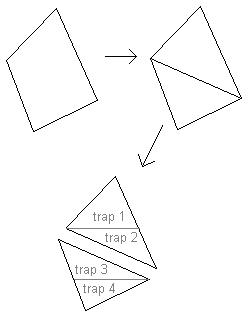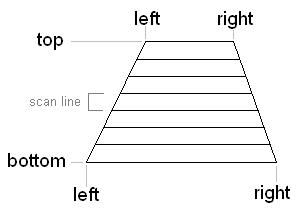Homework 6, due Thursday, Nov 4
Z-buffers!
Here we're going back to the mesh
objects that you already created,
but we'll be using the PixApplet method
for setting the color at each pixel
that you have been using for Ray Tracing.
The Z-buffer algorithm is a way
to get from triangles to shaded pixels.
You use the Z buffer algorithm
to figure out which thing is in front
at every pixel when you are creating
fully shaded versions of your mesh objects,
such as when you use the Phong surface shading algorithm.
You will want to have a list of Materials,
where each Material object gives the data that
you need to simulate a particular
kind of surface using the Phong algorithm
(eg: DiffuseColor, SpecularColor, etc.).
You will also want to have a list of Light source objects,
just as you did when you were doing ray tracing.
The algorithm starts with an empty zBuffer, indexed by pixels [X,Y],
and initially set to zero for each pixel.
You also need an image FrameBuffer filled
with background color.
This frameBuffer can be the pix[] array you currently use for ray tracing.
The general flow of things is:
-
Loop through all your polygons, where each
polygon has a list of vertices and
a Material object identifier.
-
Split the polygon into triangles, where each triangle vertex has:
- An (x,y,z) location
- A (nx,ny,nz) surface normal
-
Transform the vertices of the triangle
according to your animation.
-
Do shading/lighting on each vertex,
using the (x,y,z) and (nx,ny,nz) and
the Material properties.
After you do this,
each triangle vertex has:
- An (x,y,z) location
- An (r,g,b) color
-
Do the view transformation on the x,y,z location of each vertex
-
Do the perspective transformation on the x,y,z location of each vertex
to (px,py,pz) = (f*x/z,f*y/z,f/z), where f is focal length.
-
Do the viewport transformation on px an py, to convert them
to integer pixel values (X,Y).
-
Split the triangle into a top and bottom scan-line-aligned trapezoid.
To do this you'll need to split one of the triangle's edges,
and you'll need to interpolate the location and color
at that edge.
Each of these trapezoids has four vertex locations
on the image:
(X_TL, Y_TOP) (X_TR, Y_TOP)
(X_BL, Y_BOTTOM) (X_BR, Y_BOTTOM)
You can see the process repesented here:
First a polygon is split into triangles,
and the eacn triangle is split into scan-line aligned
trapezoids:


Each vertex of one of these scan-line aligned trapezoids
will have both color and perspective z, or (r,g,b,pz).
-
Scan convert the trapezoid by linear interpolation to get
a single span with a leftmost pixel X_LEFT and a rightmost pixel X_RIGHT.
You will have an (r,g,b,pz) at each of these ends.
-
Scan convert the single span by linear interpolation
to get an (r,g,b,pz) value at each pixel.
If pz > zBuffer[X,Y] then replace the values at that pixel:
zBuffer[X,Y] ← pz
frameBuffer[X,Y] ← (r,g,b)
-
Display the frameBuffer
A note about linear interpolation:
In order to interpolate values from the triangle
to the trapezoid, then from the trapezoid to
the horizontal span for each scan-line, then
from the span down individual pixels,
you'll need to use linear interpolation.
Generally speaking, linear interpolation
involves the following two steps:
-
Compute some linear interpolant t, where
t is between zero and one.
-
Use t to do linear interpolation between
two values a and b:
value = a + t * (b - a)
In order to compute t, you just need your
extreme values and the intermediate value
where you want the results.
For example, to compute the value of t
to interpolate from scan-line Y_TOP and Y_BOTTOM
to a single scan-line Y:
t = (double)(Y - Y_TOP) / (Y_BOTTOM - Y_TOP)
Similarly, to compute the value of t
to interpolate from pixels X_lEFT and X_RIGHT
to values at a single pixel X:
t = (double)(X - X_LEFT) / (X_RIGHT - X_LEFT)

